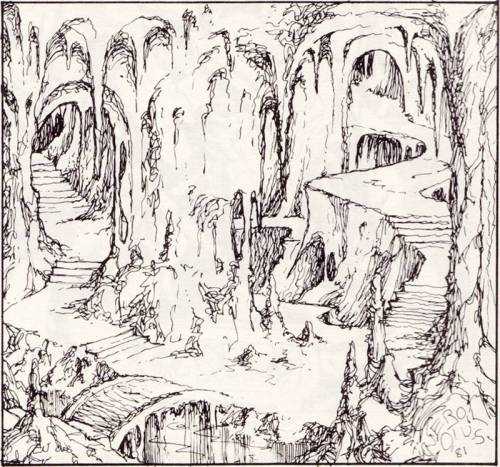I realized that training fresh-faced new GMs would be critical to bringing tabletop role-playing to my public school classroom. At the first stage, as I ran whole-class sessions, I identified those students who quickly grasped the nature of the activity, who seemed to have some enthusiasm for it, and who had social credibility among their peers (other kids would tend to listen to them). Having picked these students out, I realized that I would need to give them the proper supports before tossing them out of the boat if I was to have any hope of this experiment being successful ...
 |
| photo accessed here |
2. Equip Them with Tools that are Accessible and Evocative
At its heart, the quintessential activity of our sessions of Dagger for Kids is exploring locations, battling monsters, and looting treasure. That meant the most basic (and frequent) questions posed to the GM, and the ones he or she needed to be able to answer most readily, were likely to be of this vein:
"We open the door. What do we see?"
"What do you need to roll to hit a crocodile?"
"I rolled a 2 on my listen check. What do I hear?"
"I did 5 damage! Does that kill the ape?"
While these basics concepts would make the most frequent appearance in GM-to-player dialogue, I knew of course that there would be an entirely different layer of GM skill at work -- one that no simple flow chart or at-a-glance reference tool could begin to capture. Examples of these more subtle activities include:
- Use evocative language to describes the game environment and help players visualize and interpret it
- Interpret and "translate" the results of die rolls into engaging narrative ("Your sword stroke shears through the serpent's neck in a spray of green ichor!")
- Make spot rulings for situations not covered by the rules (jumping, climbing, picking locks, etc)
- Evaluate and adjust challenges and rewards
- Maintain a sense of suspense for players
As mentioned in an earlier post, to equip my GMs I set them up with the following:
- a dungeon map sketched inside a manila folder
- a stack of monster illustration cards
- a 3x5 reference card listing several monster stats and treasures
- blank paper for maps, sketches, and notes
- copies of Dagger for Kids
- extra character sheets
- dice
I want to take a moment and focus on two of those tools in particular: dungeon maps and reference cards.
The Dungeon Maps
- drawn on the inside of a manila folder so that the GM could easily reference it while concealing it from the players -- this was just a practical approach and I was part way through my first map before I realized that I was aping the cover folder of TSR products from the 80s.
- one GM mentioned that his players could see some of the contours (drawn in sharpie) through the folder -- until that moment I had never really questioned why The Keep on the Borderlands was rendered in that iconic light blue ... now I know!
- I didn't bother with precise scale or grid lines (heresy!) but just divided the maps into general spaces, and even that seemed to prove unnecessary.
- I wrote no separate room descriptions or room key, but annotated the maps directly in the style best seen in some of the better One Page Dungeon contest entries.
 |
| The bike I learned to ride on. |
The 3x5 Reference Cards
- monster stats had to be super short (one line)
- info had to be large enough for the GM to read at a glance but too small for players to see easily
- included more types of creatures than the GM would need in order to get fledgling GMs used to making choices and improvising
- stats appeared in the sequence in which they were most likely to be needed:
- Move ("Can they outrun us or not?")
- Armor Class ("Did I hit it?")
- Hit Points ("Did I kill it?")
- Damage ("Did I die when it bit me?")
- Special abilities (if any) that might come into play
- Experience Points awarded for defeating it
- I added a few treasures to the same card
 |
| . |
 |
| from wikipedia.org |
Now, however, I think I understand what that product was actually aiming for -- I think it was just a set of training wheels intended as a highly accessible tool for GMs who were just starting out ... something to use for that first or second adventure and then pass on to your little brother.
Reflecting personally, the longer I GM, the less I need accessible tools (I'll never need to look up an orc's armor class for the rest of my life) and the more readily I recognize potential evocative tools when I see them.
- How often have you built scenarios inspired by a single photo?
- Why did the majority of published products, even those for experienced GMs and players, continue to cleave to the same mold as the accessible tools designed to ease new players into the hobby?
 |
| Can't you see the potential for adventure here ...photo accessed here |


No comments:
Post a Comment